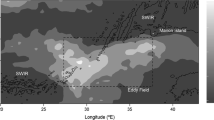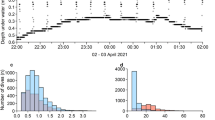Summary
A time-depth-temperature recorder provided a continuous record of diving by a female southern elephant seal in relation to water temperature for 27 days (1939 dives) after completion of moult. Mean maximum dive depth was 391±2.6 m and the overall maximum was 775 m. Dives lasted on average 17.5±0.09 min. Most dives showed a rapid descent to the discontinuity between the cold surface water and warmer deep water. Consequently the seal spent 57% of its time while diving at a depth of 200–400 m when it may have been foraging. This strongly suggests that the seal was exploiting a food source at the discontinuity between vertically stratified water masses. The water temperature data also indicated that the seal was diving in waters south of the Antarctic Polar Front and at some distance from the northern edge of the pack ice. The seal spent 88% of its time under water. Normal surface intervals between dives lasted an average of 2.1 ± 0.1 min whereas 16 extended surface intervals (>10 min duration) lasted 32.7±4.6 min. Dives were deeper during the day than at night and all but one extended surface interval occurred at night. The pattern of dives was similar to records from northern elephant seals but this is the first study to show how diving behaviour relates to water temperature.
Similar content being viewed by others
References
Baker JR, Fedak MA, Anderson SS, Arnbom T, Baker R (1990) Use of a tiletamine-zolazepam mixture to immobilise wild grey seals and southern elephant seals. Vet Rec 126:75–77
Clarke MR (1980) Cephalopods in the diet of sperm whales of the Southern Hemisphere and their bearing on sperm whale biology. Discovery Rep 37:1–324
Clarke MR, Macleod N (1982) Cephalopods in the diet of elephant seals at Signy Island, South Orkney Islands. Br Antarct Surv Bull 57:27–31
Croxall JP, Prince PA, Ricketts C (1985a) Relationships between prey life-cycles and the extent, nature and timing of seal and seabird predation in the Scotia Sea. In: Siegfried WR, Condy PR, Laws, RM (eds) Antarctic nutrient cycles and food webs. Springer Berlin Heidelberg New York, pp 516–533
Croxall JP, Everson I, Kooyman GL, Ricketts C, Davis RW (1985b) Fur seal diving behaviour in relation to vertical distribution of krill. J Anim Ecol 54:1–8
Deacon GER (1937) The hydrology of the Southern Ocean. Discovery Rep 15:1–124
Falke KJ, Hill RD, Qvist J, Schneider RC, Guppy M, Liggins GC, Hochachka PW, Elliott RE, Zapol WM (1985) Seal lungs collapse during free diving: evidence from arterial nitrogen tensions. Science 229:556–558
Gentry RL, Kooyman GL (1986) Fur seals: maternal strategies on land and at sea. Princeton University Press, Princeton, 291pp
Guppy M, Hill RD, Schneider RC, Qvist J, Liggins GC, Zapol WM, Hochachka PW (1986) Microcomputer-assisted metabolic studies of voluntary diving of Weddell seals. Am J Physiol 250:R175-R187
Halsey MJ (1974) Structure-activity relationships of inhalation anaesthetics. In: Halsey MJ, Miller RA, Sutton JKA (eds) Molecular mechanisms in general anaesthesia. Churchill Livingstone, Edinburgh, pp 3–14
Hochachka PW, Somero GN (1984) Biochemical adaptation. Princeton University Press, Princeton, 537pp
Kooyman GL (1966) Maximum diving capacities of the Weddell seal (Leptonychotes weddelli). Science 151:1553–1554
Kooyman GL (1989) Diverse divers: physiology and behaviour. Springer, Berlin Heidelberg New York, 200 pp
Kooyman GL, Gentry RL, Urquhart DL (1976) Northern fur seal diving behavior: a new approach to its study. Science 193:411–412
Kooyman GL, Wahrenbrock EA, Castellini MA, Davis RW, Sinnett EE (1980) Aerobic and anaerobic metabolism during diving in Weddell seals: evidence of preferred pathways from blood chemistry and behaviour. J Comp Physiol 138:335–346
Laws RM (1977a) Seals and whales of the Southern Ocean. Philco Trans R Soc London, Ser B 279:81–96
Laws RM (1977b) The significance of vertebrates in the Antarctic marine ecosystem. In: Llano GA (ed) Adaptations within Antarctic Ecosystems. Proc 3rd SCAR Symp Antarct Biol. Smithsonian Institute, Washington DC, pp 411–428
LeBoeuf BJ, Costa DP, Huntley AC, Kooyman GL, Davis RW (1986) Pattern and depth of dives in northern elephant seals, Mirounga angustirostris. J Zool, London 208:1–7
LeBoeuf BJ, Costa DP, Huntley AC, Feldkamp SD (1988) Continuous, deep diving in female northern elephant seals, Mirounga angustirostris. Can J Zool 66:446–458
LeBoeuf BJ, Naito Y, Huntley A, Asaga T (1989) Prolonged, continuous, deep diving by northern elephant seals. Can J Zool 67:2514–2519
McCann TS (1985) Size, status and demography of southern elephant seal (Mirounga leonina) populations. In: Ling JK, Bryden, MM (eds) Studies of sea mammals in south latitudes. South Australian Museum, Adelaide, pp 1–17
McCann TS, Rothery P (1988) Population size and status of the southern elephant seal (Mirounga leonina) at South Georgia, 1951–1985. Polar Biol 8:305–309
McCann, TS, Fedak MA, Harwood J (1989) Parental investment in southern elephant seals, Mirounga leonina. Behav Ecol Sociobiol 25:81–87
Naito Y, LeBoeuf BJ, Asaga T, Huntley AC (1989) Long-term diving records of an adult female northern elephant seal. Antarct Rec 33:1–9
Papastavrou V, Smith SC, Whitehead H (1989) Diving behaviour of the sperm whale, Physeter macrocephalus, off the Galapagos Islands. Can J Zool 67:839–846
Priddle J, Heywood RB, Theriot E (1986) Some environmental factors influencing phytoplankton in the Southern Ocean around South Georgia. Polar Biol 5:65–79
Rodhouse PG (1988) Distribution of the neoteuthid squid Alluroteuthis antarcticus Odhner in the Atlantic sector of the Southern Ocean. Malacologia 29:267–274
Rodhouse PG, Clarke MR (1985) Growth and distribution of young Mesonychoteuthis hamiltoni Robson (Mollusca: Cephalapoda): an Antarctic squid. Vie Mileiu 35:223–230
Rodhouse PG, Clarke MR (1986) Distribution of the early-life phase of the Antarctic squid Galiteuthis glacialis in relation to the hydrology of the Southern Ocean in the sector 15° to 30°E. Mar Biol 91:353–357
Rodhouse PG, Arnbom T, Fedak MA, Yeatman J, Murray AWA (1991) Cephalopod prey of the southern elephant seal Mirounga leonina L. Can J Zool (in press)
Smith RA, Dobson BA, Miller JN (1984) The interactions between pressure and anaesthetics. Philos Trans R Soc London 304: 69–84
Toole JM (1981) Sea Ice, winter convection, and the temperature minimum layer in the Southern Ocean. J. Geophys Res 86:8037–8047
Author information
Authors and Affiliations
Rights and permissions
About this article
Cite this article
Boyd, I.L., Arnbom, T. Diving behaviour in relation to water temperature in the southern elephant seal: foraging implications. Polar Biol 11, 259–266 (1991). https://doi.org/10.1007/BF00238460
Received:
Accepted:
Issue Date:
DOI: https://doi.org/10.1007/BF00238460




